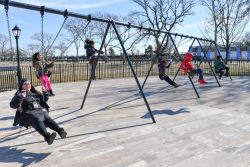Asser Levy Park
Hennessey Triangle
Hennessey Triangle lies at the eastern tip of Asser Levy Park, a 22-acre area that includes the New York Aquarium and Seaside Beach Park. It was named in honor of William J. Hennessey (1890-1918) by the Board of Aldermen (precursor to the City Council) in 1931. Hennessey was a former resident of nearby West 1st Street. He served as a private in Company A, Fourth Infantry Division during World War I, the only division active in both the English and French sectors of the Western front. He was killed in action on October 9, 1918. A flagpole with a plaque honoring the memory of Private Hennessey was erected in this park in 1938 with funds donated by the local Veterans of Foreign Wars post.
Asser Levy Park is part of the Coney Island Complex. One of the earliest beach resorts, Coney Island began attracting visitors after the construction of the Coney Island House in 1924. A highly diverse crowd of luminaries joined the wealthy vacationers at this fashionable hotel. Writers Washington Irving and Herman Melville, politicians Daniel Webster and Henry Clay, as well as P.T.Barnum and Jenny Lind enjoyed its facilities.
The City of Brooklyn acquired the original parcel of land for a public park in 1875 by order of the Board of Estimate. Seaside Park, as it was called, attracted 200,000 visitors a day. In the 1880’s, when salt-water bathing became an acceptable activity, its popularity increased still further. With the completion of the Brooklyn Bridge in 1883 and the extension of BMT subway in 1920, Coney Island could expect up to a million visitors on a hot day. Eating establishments like Feltman’s and Nathan’s introduced the hot dog, making it synonymous with Coney Island and drawing additional crowds. In 1921, the City acquired title to the property along the beachfront and added another 2.5 million square feet to the beach area.
The tradition of the Coney Island hot dog goes back to 1867. Charles Feltman, a purveyor of freshly baked pies from his pie-wagon, answered his clients’ demands for hot sandwiches by serving hot sausages on a roll. In 1871, he bought a small plot of land and set up a stand. A few summers later, he had built the Ocean Pavilion on a substantial piece of property. By the turn of the century, Feltman’s had developed into a series of restaurants serving hearty German fare and featuring beer gardens, ballroom dancing, and entertainment. 5,230,000 customers patronized Feltman’s in 1923, most of them buying 10-cent hot dogs.
In 1915, Nathan Handwerker took a job at Feltman’s slicing hot dogs. In less than a year, he had saved enough money to open his own establishment and installed counters in the ground floor of a building on Surf and Stillwell Avenues. He began selling hot dogs for a nickel. Strategically located near the entrance of the new BMT subway station, success was inevitable. On Decoration (Memorial) Day 1954, Nathan’s sold 55,000 hot dogs. Nathan’s remains at its original location, still selling over one million hot dogs a year. The annual Fourth of July Hot Dog Eating Contest celebrates Coney Island’s century-old culinary institution.
Check out your park's Vital Signs
Clean & Safe
Green & Resilient
Empowered & Engaged Users
Share your feedback or learn more about how this park is part of a
Vital Park System










